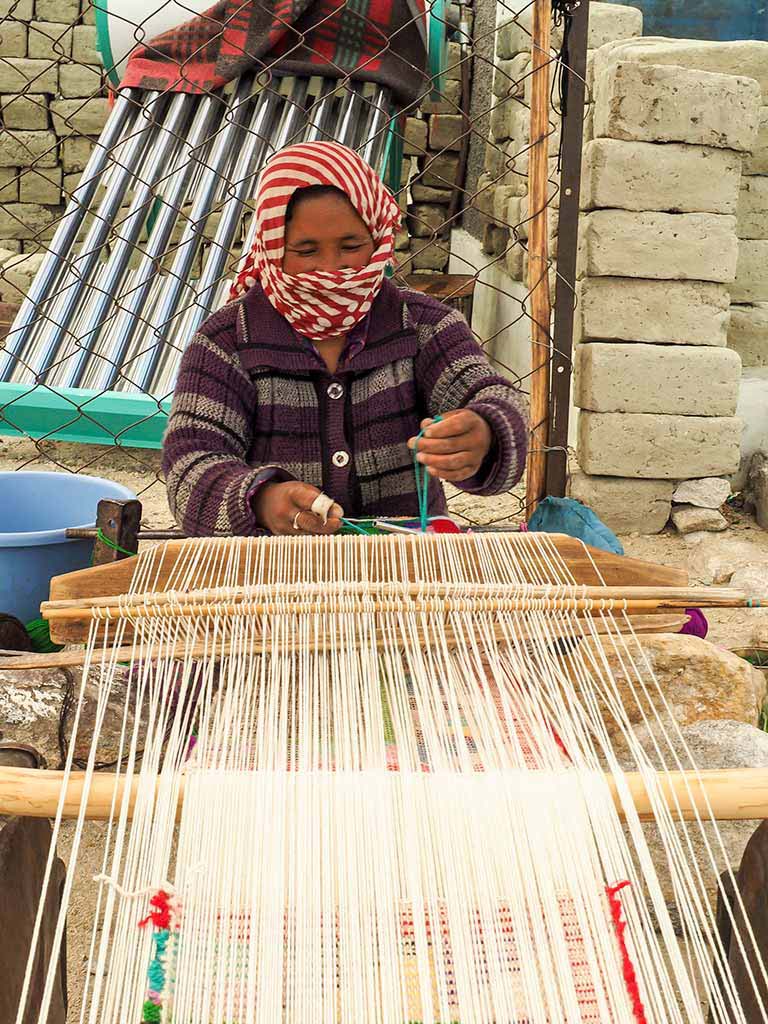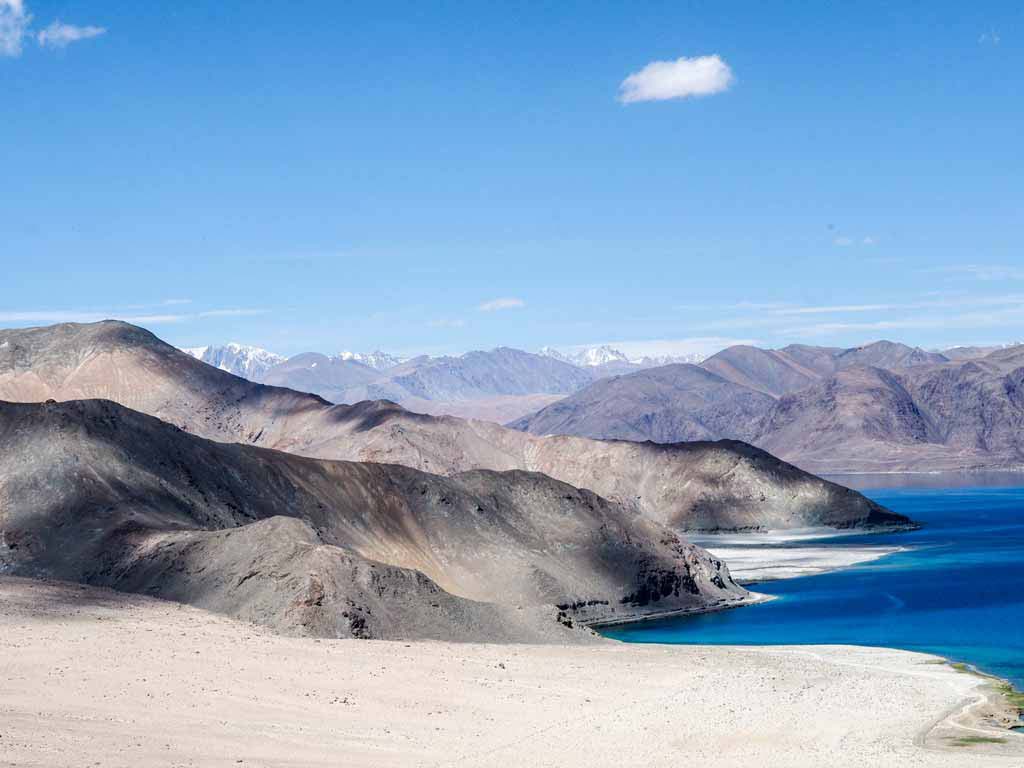On the border
21st August 2017: An early start for our drive from Leh to Pangong Tso, the lake that straddles the India/Tibet China border in the region known as Changtang, which the Silk Road passed through between Ladakh and Tibet, north of Mt Kailash and south of the Kun Lun mountains.
The early morning roads are quiet and we avoid the traffic in lower Leh until we hit the roadworks by the main Leh gateway and a diversion takes us through back streets.
In 2010 this area was washed away by a flash flood a couple of days after we arrived. Leh was completely cut off for a week and we spent several days helping to dig mud out of hospitals and homes. Most of the damage has been repaired but we can see some remnants of destruction.

We stop for breakfast at the Pangong Retaurant at Karu just before the road turns north to leave behind the Leh Manali highway.
The road passes the monastery of Chemre and a prosperous farming valley near Tak Tok before climbing to 5600 m at the Chang La. The road is being rebuilt to permit more traffic but in the interim we have to take the very slow old road and the journey takes longer than last time.
The glacier that sits above the pass appears to have shrunk, there is very little snow this year and the temperature is not so biting.

Last time we were here we cycled down from the pass on mountain bikes until I fell off whilst attempting to take a video and cycle at the same time.
That involved a visit to the hospital at Tingre where my elbows, knees, stomach, back and face were all swaddled in an excessive quantity of bandages that left me unable to feed myself and caused much hilarity. I also shredded a beautiful Hawaiian shirt that for mysterious reason I'd chosen to wear. This time we are taking no risks and drive straight to the lake.

The lake, surrounded by dramatic hills, is utterly beautiful but the first two settlements have been ruined by hundreds of fixed tents arranged for the Indian tourists who come to see the lake and the setting used in a couple of very popular Bollywood films. If you're from England, think 1950's Blackpool.

We drive on to the small village of Merak where we spend the next couple of nights in a simple homestay.
This is the high altitude plain of Changtang, the partly nomadic area that extends into Tibet and China. In fact there are still nomads here but the Indian government is giving an incentive to people to occupy fixed settlements here, partly to lay claim to the land which is also claimed by China.
Shadows are lengthening by the time we arrive and it promises to be a cold night. The people here look more Tibetan than Ladakhi, faces are broad with sunburnt red cheeks and Tibetan eyes.

We eat in the kitchen with the family, mother, son, daughter and the grizzled old father in law who turns up for his evening meal.
The young boy is voraciously looking at everything we have and testing us out with his English, he promises to be a character.
Grandfather has had quite a life we suspect. At one time he crossed over the border into China ostensibly on a trade mission but acting surreptitiously as a spy with a brief to come back and report on whatever was happening.


In the morning we awake to find Stanzin, our guide, trying to work the loom that sits outside the house. "Ama" takes to the loom whenever she has spare time and weaves small colourful woolen carpets that are dotted around the house.
She has a shy smile which we occasionally glimpse when she removes the headscarf which stays in place whenever we ask to take her photograph.

The kids get dressed in their school uniforms and walk off to school together. The young boy has obviously taken to Graham's spiky hair and this morning, before school, is sporting a rakish Mohican. The altitude is higher than Leh, the air is thin and the idea of walking seems a little far-fetched but we eventually find our legs and walk over to the small gompa on the crown of a hill half a mile away.
The route takes us through newly built scattered single storey houses that seem to be the characteristic of this village although in the distance we can see some older, grander houses down near the lake.
The gompa is modest but a new larger room is being built at the rear and we understand that a lama comes once a month to conduct basic rituals and prayers. There is a stone with an opening outside the gompa, crawl through if you dare - if you get stuck you may not have a favourable rebirth! Being slim, we pass through.

With growing confidence we climb the larger hill that overlooks the village, it's a slow haul but the views from the top extend down the lake to the bend just before the border. Pangong is long and narrow, much of the length is in China but most of the volume of water is in India.
The colour is an extraordinary deep blue with pale turquoise in shallower waters close to shore. The white sandy beaches are punctuated by deep green wetlands extending into deltas.

Below us the irregular oval shaped fields typical of Ladakh are turning gold as the barley ripens, ready for harvesting. An Indian motorcyclist from Hyderabad climbs the hill and spends some time with us underneath the prayer flags on the summit.
Later we'll talk with his mate who stayed behind at the bottom of the hill and seems to be full of admiration for our trekking intentions. He's half our age and resolves to stop smoking.

We descend past a stone circle, the threshing space where animals will walk around in circles once the harvest has been brought in.
In the afternoon we take our cameras as we walk along the shore marvelling at the sandbanks, the changing colour of the hills and the wading birds, but a cold wind has sprung up, there is cloud cover and with only a thin shirt my fingers are numb with the cold.
The sun breaks through while we're walking back bringing warmth and extra beauty to the scene.


Back at our lodgings the young girl has got a playmate and there's lots of shouting and laughing as they pull faces for our cameras. Our room is comfortable, big cheap Chinese carpets cover the floor and there are painted Tibetan tables.
The family are more relaxed with us tonights as we sit in the kitchen to eat. One wall is full of decorative Chinese bowls and we resolve to buy some for Stanzin and his wife Sonam once we are back in Leh. Grandfather sits cross-legged spinning wool.


Time for our drive back to Leh but we are reluctant to leave the lake. Although the colours are so intense, black-and-white seems to capture the drama more clearly.
At the west end of the lake there is a beautiful white hill that we remember from last time, it's on the opposite shore where it's difficult for us to go. The return drive back to Leh is faster is spite of a long convoy of army lorries. Next: Silk Road from Leh towards Kargil and Gyal
Next: Silk Road from Leh towards Kargil and Gyal
